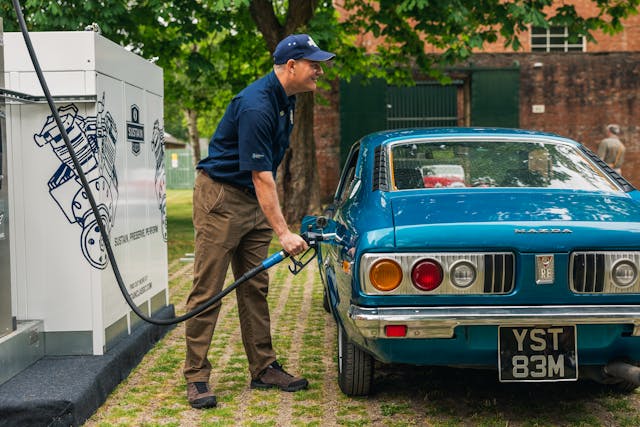Media | Articles
Your guide to sustainable fuels
Under pressure from car makers and consumers, the European Union looks set to allow the continued production of internal combustion–powered cars beyond 2035—as long as those vehicles run exclusively on carbon-neutral fuel.
The decision would extend the life of the automobile and its Otto cycle, giving drivers a choice of what to drive—old, new, hybrid, ICE-only—rather than simply forcing them into electric vehicles.
There’s no need to wait until you’re told, however. There are already a number of sustainable fuels on the market that can cut your carbon footprint—although by how much and at what cost is a massive variable.
Regardless of the methods, which we’ll come to, the goal of these automotive cocktails is the same: to end the auto industry’s reliance on fossil fuels and dramatically cut carbon emissions.
“Crude oil is an embedded carbon, it’s safely locked away in the ground, not causing any sort of damage to the environment,” explains David Richardson from British fuel firm Coryton. “And ideally, that’s where we would keep it so that we’re not then releasing that carbon through to the environment, and adding to greenhouse gases, and the warming effects that you get. When you take the crude out, you turn it into a fuel and you burn it, you’re releasing that carbon energy into the environment as a new carbon source.
Marketplace
Buy and sell classics with confidence
“Where we are with the sustainable fuels, you’re effectively recycling the carbon that has already been released into the environment either through burning fossil fuels or through other industry processes or just natural CO2. So, what you’re really doing is you’re looking for a way that is efficient at capturing that carbon into something that you can then process to turn it back into a liquid fuel.”
In addition to hydrogen, which automotive engineers have tinkered with since 1807, two different technologies have emerged in the realm of sustainable fuels: e-fuels and bio-fuels— and yes, they’re different. Let’s break each down.
Bio-fuels
Put simply, bio-fuels are those that are based on (recently living) biological materials. Those could be crops crown purely for the purpose of producing fuel, or, a rather better option, waste products of crops grown for food.
“Using biomass works really nicely because we have Mother Nature doing all the heavy lifting for us. She’s very efficient at absorbing carbon dioxide,” says Richardson.
The pump gas found in most of the world contains a portion of bio-fuel in the form of ethanol. In Europe, it comprises between five and ten percent of the mixture, while in the U.S., it’s typically ten (E10)—although E15 and even E85 (for flex-fuel vehicles) is also available.
While ethanol-cut gasoline does cut the amount of crude oil consumed, and therefore, reduce net carbon emissions, high ethanol content makes this option unsuitable for older vehicles. That’s because ethanol is corrosive and can eat away at plastic, rubber, and metal components in the fuel system. It’s also hygroscopic, which means it absorbs water from the atmosphere, which can lead to condensation.

Coryton’s Sustain fuels solve this problem thanks to a chemical process that eliminates ethanol almost completely. Raw materials from agricultural and food waste go through an initial fermentation stage that turns them into ethanol. A further two-stage catalytic process changes the chemical structure into that of a hydrocarbon fuel with barely a trace of ethanol.
This fuel is then blended with a fossil-based gasoline to produce three blends: Super 33, Super 80, and Racing 50. (The numbers refer to each fuel’s minimum sustainable content.) Coryton claims that, factoring in the manufacturing process, Super 80 can save 65 percent greenhouse gas emissions compared to a conventional high-octane unleaded fuel.
The fuel is a direct swap for pump gas and Coryton claims there are no negative effects. We certainly didn’t notice any when we tried it in a Jaguar E-Type; we will soon be putting it to the test in an eight-hour endurance race, so stay tuned.

At the moment Coryton’s fuels are prohibitively expensive (around double the price of pump gas) and limited in availability, although the company is increasing the number of outlets (from one) in the U.K., and has supplied small batches all over the world, including to the U.S.A., typically for classic-car and motorsports events.
Coryton adds that its current plant could produce up to 30 million liters (8M gallons) of sustainable fuel per year and that there is enough agricultural waste in Europe to fuel all of the continent’s cars, light trucks, and motorcycles.
Cost and performance requirements mean that the company’s current fuels can’t meet Europe’s zero-carbon requirements, but as one of the processes actually absorbs more carbon than is emitted when the fuel is burnt, a fully neutral version is theoretically possible.
Until then, the only way to a truly zero-net carbon gasoline is through e-fuels.
E-fuels
Where bio-fuels use the carbon captured in plants as one of their key building blocks, e-fuels rely on carbon directly pulled from the atmosphere. This is then combined with hydrogen to create those hydrocarbons we all crave.
E-fuels may sound like the perfect solution, but the biggest problem is just how much energy is required to create them. Where that energy comes from dictates whether the fuel is carbon-neutral or not.
Capturing carbon from the air and releasing hydrogen from water via electrolysis needs a lot of electricity. If that electricity comes from the grid then there could be fossil fuels such as natural gas or coal in the mix.
That’s why Porsche’s e-fuel venture is located in Chile and powered by an abundance of wind turbines. Porsche claims that, compared to current pump gas, its e-fuel could reduce greenhouse gas emissions by up to 85 percent. To get to that magic 100 percent mark, as required by Europe, the fuel must be transported, and even pumped, only using renewable energy.

Initially producing fuel to support Porsche racing programs, the factory will ultimately be able to produce some 550 million liters (145.3M gallons) of e-fuel.
As with much technology transfer, motorsports leads the way. In Britain, P1 Fuels uses a combination of carbon capture and biomass to create its fossil-free fuel and has fueled karting, historic racing, and rallying, even the World Rally Championship.
What about hydrogen?
The most abundant element in the universe has many advocates. Hydrogen can be used to create electricity by chemical reaction in a fuel-cell or it can be burned in an internal combustion engine. Either way, the only emission is water vapor—there’s not a carbon atom in sight.
Of course, hydrogen is not without its drawbacks. For one, the production of true green hydrogen can only be done through electrolysis using clean energy—just as e-fuel is. There’s also blue hydrogen, which can be extracted from natural gas, but that defeats the object.

Toyota has successfully run rally and race cars on hydrogen, and even built two iterations of its Mirai sedan. Ambitious startups such as Hyperion also reckon hydrogen is the way forward.
However, it’s also notoriously difficult to store: It must be contained at high pressure in liquid form, since it has a tendency to escape at every opportunity.
So far the public hasn’t exactly embraced H2, and the number of global hydrogen filling stations across the world is just 814, according to the latest figures from Hydrogen Central. As with e-fuel, for hydrogen to be truly carbon neutral its whole supply chain would need to be sustainably powered.
When it comes to creating a 100 percent sustainable fuel that can keep beloved classics and future exponents of internal combustion on the road, we are not there yet. The good news is that there are a number of routes to explore, and even now there are options to reduce your carbon footprint and still enjoy driving as Otto intended.
***
Check out the Hagerty Media homepage so you don’t miss a single story, or better yet, bookmark it. To get our best stories delivered right to your inbox, subscribe to our newsletters.














Sorry but none of this is going to work in any near term sense. The average collector car owner wallet will not sustain the cost of these options.
Gas is not going away. Oil is not going to run out in our life time. For our needs we should still be able to get what we need as long as they don’t go dumping more ethanol in it.
In place of this woke game companies that support our hobby need to join SEMA and others to make sure our hobby still can get the oils and fuels we need to enjoy our vintage cars.
If they park us there is no need for insurance. Hint!
You do not need to introduce political baggage and buzzwords here.
You make some very salient points — nevertheless, unless and until major reductions are made to our now-toxic species’ habits, then there simply may not be a future; at least not as we hope for.
Those who have children and grandchildren should be the MOST concerned and involved, but for whatever reason, it now falls to the children themselves, along with a few childless geezers like me, to speak out.
You’ve revealed that you’re in this for “the near term”: “For our needs we should still be able to get what we need…”
No, “Oil is not going to run out in our life time”; but for many, lives might run out prematurely, but at least they’re well-oiled.
‘You do not need to introduce political baggage and buzzwords here,” says the guy who writes “our now-toxic species’ habits” and alleges “lives might run out prematurely” (allegedly due to continued reliance on oil) and ‘Unless there’s an ACCEPTANCE and RECOGNITION that THERE IS A PROBLEM in the ENVIRONMENT — CAUSED BY HUMAN ACTIVITY; then we truly deserve the unavoidable worsening of what is now causing so much unprecedented destruction and misery.” All I can say to that is, “Lighten up, Francis” and please practice what you preach.
I will gladly pay (well maybe not gladly) double the price of liquid dinosaur to keep my ICE machines going. I would also bet that if these alternatives get popular, that double the price mark will drop
The truth is there is no reason to pay double. Now is the time to stand for what is right. We are not killing trees and the number of cars we drive have little to no impact.
The reality is this will never be just double the price. It will be much more.
It’s a lot of work to do a solution that works at a lower level than the existing solutions. It’s ultimately about control. This fascination with batteries isn’t the solution they pretend it is but it is being shoved down our throats. Why not use a combustion motor as an electricity generator and ditch the batteries?
Isn’t the goal of this search for alternate energies about emission reduction? I do agree that battery only looks to pose a problem down the line. What the solution is, who knows.
I read a 40,000 mile C&D test on a Tesla and the charging at one charging station was double the cost/mile of gasoline.
Musk isn’t putting in all thise stations just to be nice.
I doubt it was a Tesla Supercharger that was double the cost per mile of gasoline. I just returned from a 4500 mile trip from the midwest to California in my Tesla and my costs for Supercharging were 1/4 the cost of gas.
It will cost more to run electric vehicles than internal combustion engines once there are enough EV’s in service.
https://www.caranddriver.com/reviews/a30209598/2019-tesla-model-3-reliability-maintenance/
“Supercharger prices during our least efficient month works out to 22 cents per mile.”
“our long-term BMW M340i filled with 93-octane premium (10.7 cents/mile). “
Nik, I thank you for a most even, informative and level-headed article.
It seems that everyone’s got feelings and opinions on this, which is fine — ALL ideas should be considered.
It is when selfish personal wants, and purely politically ideologies are driving the directions, that real progress is hampered.
Unless there’s an ACCEPTANCE and RECOGNITION that THERE IS A PROBLEM in the ENVIRONMENT — CAUSED BY HUMAN ACTIVITY; then we truly deserve the unavoidable worsening of what is now causing so much unprecedented destruction and misery.
No Plan(et) B. Fix this one — Home.
Carmine, easy with the political posturing. I read the Hagerty articles for information, entertainment, and sometimes to merely have a brief time to escape the non-stop political rat race of the world. I would appreciate very much if you would save the political comments for another venue.
You are absolutely right.
However, you should note that I said nothing of any political nature.
Mine was purely a reply to the posting above mine.
Peace.
I personally think we need to spend a little more time looking at the number of humans doing things than what they are doing. I bet if you look at the rate carbon is increasing in the atmosphere and compare it to the population growth, you will see some considerable correlation. Unfortunately every time we conserve, we just make room for more, so it almost seems like it just makes more sense to waste as much as we can. Burn all them dinosaurs up, weather the consequences, and move on
TG, totally agree. (This won’t be popular but…) If global warming is a real thing, hopefully it will continue to get worse. Then there will droughts and crop failures and famine and 3 to 5 billion people will die. Then the world will have a very sustainable population of about 2 to 3 billion (hopefully less) and then everything will work itself out. 8 billion and rising rapidly is a little too much for this place to handle. In the end no matter what we do today or ever really matters because we are all going to die.
Carpe Diem.
P.S. Fossil Fuels are not just dinosaurs, if they ever really were. https://www.plasticstoday.com/materials/sorry-folks-oil-does-not-come-dinosaurs
Gas and Oil are the best renewable fuel sources. If they are called ‘fossil’ fuels because they originate from dead dinosaurs, the last time I looked, living things have been dying and decomposing ever since dinosaurs roamed the earth, so all those creatures have been in the ground slowly turning into tomorrow’s fossil fuel for thousands of years.
We are talking about renewability and sustainability in terms of human lifespans. The human population burns through 1 billion barrels of oil in about 12 days. That is certainly not renewable/sustainable by natural fossil processes at the present rate. By your glib logic solar energy is not renewable because the sun will burn out in a few billion years.
Hey john — YES, they’ve been IN THE GROUND, for MILLIONS of years actually.
Some more facts: It’s really the VEGETATION that contains the carbon-energy-rich stuff.
Not dinosaurs. They’ve left almost nothing of themselves behind.
TECHNICALLY, oil is NOT “renewable”.
Since it took millions of years for it to occur, then we ourselves would need to wait millions of years to produce more.
You see — all of that ancient Plant material required all that time, to become the underground oil-type resources they are.
It is THEY who contain massive amounts of Carbon.
Extracting it, and then burning it for energy, is how WE HUMANS have put all that carbon BACK INTO OUR ATMOSPHERE.
To LEAVE IT IN THE GROUND is the very BEST WAY to treat it.
Down there, it harms no-one.
Just leave it there.
Let the market do its job.
Get the govt. out of the way
Why won’t anyone discuss propane or natural gas? It’s cheap plentiful and burns clean. Australia and Europe use it, it is a great available alternative.
If you add carbon to the definition of clean, they do not burn clean
Alcohols are partially oxidized hydrocarbons; this means that they have lower energy content than pure hydrocarbons. Adding alcohol to fuel lowers fuel economy, as well as inviting water absorption, corrosion, and gumming of jets or injectors, even if more recent fuel system components are not attacked by it. It shortens fuel storage longevity. Its one saving grace is that it raises octane rating as it takes the place of tetraethyl lead. Growing and processing corn to create ethanol uses a great deal of energy, frequently using fossil fuels in the process. It is hardly a zero-carbon solution. Hydrogen, along with all its storage issues, has an even lower specific energy than any alcohol. It’s nice that they are looking for alternative to fossil fuels, but that technology has very far to go before it is practical.
I was edumucated on the role alcohol plays in gasoline… it is actually being used as an octane booster. The one very popular octane booster we used for years was lead. There would probably be alcohol in fuel regardless of the global warming situation. The reason that the Hellcat 170 is called 170 is because that is the ‘proof’ of the fuel required to achieve its 1000 hp
Audiobycarmine said not a political word, only what some don’t want to hear. We’ve found that the first to yell “no politics” veer to one direction and haven’t the vetted knowledge to confront reality past their hood ornaments.
Instead of playing us/them, parsing, equivocating, passing the buck, if we’re serious about buying time beyond the EU’s 2035 deadline, or future permits, ordinances, bans, fines for driving i.c. cars here in the States, we have to triage, focus on the two juggernauts making our old cars convenient scapegoats for the round up the usual suspects crowd.
Both are science. Simple, if not EZ. We’re on a planet so small the towers of suspension bridges out of parallel to deal with the earth’s curvature, 8.1 billion people all burning some form of carbon, 350 million babies onboard here in the US. Every poll of scientists shows them agreeing overpopulation remains our biggest by far problem, their words: “bigger than climate.”
2. UN and other studies show animals raised for meat and dairy produce more greenhouse gas than all the world’s cars, trucks, buses, trains, planes, ships combined. Reread the previous sentence.
Americans are long spoiled by living on a huge continent still seen as vast cornucopia, so we’re home of the “having-it-all” mentality. No one can say if not born 2024, might not be born 2824, 5624, or 16824. First, we revise our antiquated, agrarian tax code from when more babies meant more hands to work the family farm, half of all children not surviving beyond age four, to instead encourage –not mandate — having “one or none” and adopting. We pressure the Pope and other religious leaders to encourage their followers to do the same.
Secondly, we follow the world’s leading Formula One driver, Lewis Hamilton, in adopting a plant-based vegan diet, which in the win-win-win is the single best prevention of heart disease, cardiovascular problems, inflammation, hypertension, diabetes, cancer, macular degeneration, dementia (now termed type 3 diabetes), Alzheimer’s.
Hard to enjoy your car when you’re ailing.
Sorry, but acting today to preserve our future, our cars, ourselves, includes “politics,” and even, “religion.”
As automobiles freed us from streets paved with manure, lined with carcasses of horses worked to death, EVs require cobalt, lithium, nickel, manganese imported from unstable realms, there’s NIMBYism in disposing, recycling batteries, most urban dust remains tires, and how is most of the electricity produced. Without curbing overpopulation and how we fuel ourselves, EVs remain another Band Aid on the patient hemorrhaging in the ER.
We now return to our usual us/them, buck-passing, parsing, equivocating, escapism, live for today bar room rants, already in progress.